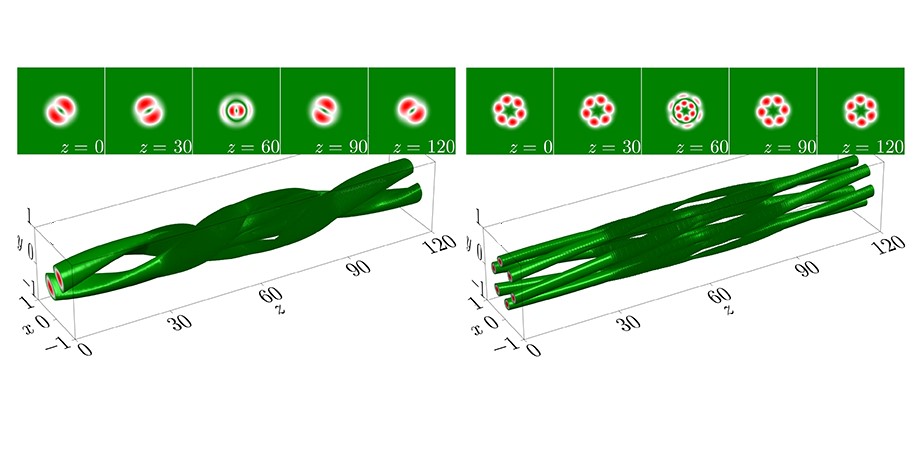XI’AN, China, Aug. 13, 2020 — A research team from Xi’an Jiaotong University has demonstrated weakly nonlinear waveguides that guarantee the stable propagation of vortex beams known as azimuthons. The research may have applications in encoding and encrypting optical information. Azimuthons carry an orbital angular momentum and can now be made to exhibit a mutual conversion pattern known as Rabi oscillation — a periodic motion between two different energy levels in the presence of an oscillatory driving field.
The team determined specific requirements for a weak nonlinearity: first, that both the linear and nonlinear induced index changes are small compared to the ambient refractive index, and second, that the induced nonlinear index change is much smaller than the linear one. Theoretical investigations demonstrated that the depth of the induced potential is tightly related to the transverse size of the waveguide. This indicated that the multimode optical fibers could be used to obtain a deep potential energy well that would also allow for shallow modulation.

Azimuthon transition between dipole and hexapole. Courtesy of Yiqi Zhang et al.
With that in mind, Yiqi Zhang and his colleagues developed a weakly nonlinear waveguide that is explicitly multimode. The researchers paired various modes with different modal distributions. By introducing a π-phase shift and an amplitude modulation to one mode and then superposing the other, they obtained an azimuthally modulated vortex. Thanks to the presence of nonlinearity and a weak longitudinally periodic modulation to the potential, the azimuthally modulated vortex rotates with a fixed angular velocity during propagation and exhibits Rabi oscillation between the two modes.
The researchers noted the spatial symmetry of the propagating beam will change periodically in the process. According to coupled-mode theory, Rabi oscillations are affected mainly by the longitudinal modulation strength and the spatial symmetry of the superimposed azimuthons. Without longitudinal modulation, the azimuthon rotates with a constant velocity and its profile is preserved. But with slight longitudinal modulation, mutual conversion of different azimuthons can be observed during propagation.
“Since our model supports higher-order azimuthons with higher topological charges, there are many choices to select the orbital angular momentum carried by the light beams,” Zhang said. “However, the Rabi oscillation can only happen between azimuthons with certain profiles. We now have some ideas for how to overcome that limitation, so we’ll continue our investigations.”
Beyond its promise for enhancing optical information processing, the demonstration of Rabi oscillations of azimuthons contributes to a better understanding of the rotational dynamics of vortices and the inherent role of nonlinearity in regulating those dynamics. Intrigued by spatial field manipulation in nonlinear optical systems, the researchers said their findings are important for potential advances in photonics — for example, in helical waveguides or topological insulators. More broadly, their insights may improve understanding of such everyday phenomena as cyclones or tornadoes, or vortices forming in the wake of an airplane.
The research was published in Advanced Photonics (www.doi.org/10.1117/1.AP.2.4.046002).